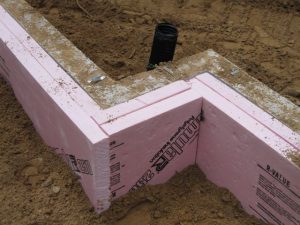I’ve touched on the subject of Frost-Protected Shallow Foundations in a previous article (https://www.hansenpolebuildings.com/2012/10/concrete-slab-4/), but never truly taken a dive into the pond to expound upon them as they relate to post frame construction.
 My friend KEN from MANCOS recently contacted me for information, which got this subject restarted:
My friend KEN from MANCOS recently contacted me for information, which got this subject restarted:
“Mr. Pole Barn Guru,
I am planning a pole barn build next spring, so currently trying to figure out the little details.
I know you said only one question, but I am greedy for knowledge so I am asking two.”
1) Ken resubmitted his question and included his email address for faster response. You can read both the question and the answer in this column November 21, 2016.
“2) For a conditioned workshop, what would you recommend for slab edge insulation (Colorado) and how would install it?
BTW Your site has been most informative. And if you really are going to limit me to one question I would prefer the answer to 1 over 2.
Thanks Ken”
Long term readers of this column have probably gotten the drift of my love of discussing all things post frame building. Whether you have only one or a hundred questions you are looking to have answered send them my way. The only stupid question is one which never gets asked, and chances are if you ask a question, there are several other people out there who were too shy or too busy to have asked themselves. Kudos to you for beating them to the punch!
The U.S. Department of Housing and Urban Development Office of Policy Development and Research has been so kind as to publish a plethora of information on the subject of Frost-Protected Shallow Foundations, which (while not specific to post frame construction) would apply to any structural building system. Heat transfer truly doesn’t care how you put the structure together, just so long as the resistance issues are taken care of adequately.
Those who are considering Frost-Protected Shallow Foundations should peruse this information: https://www.huduser.gov/publications/pdf/fpsfguide.pdf, and utilize it to determine the requirements for insulation R values, as well as the depth to which vertical insulation boards should be placed, as well as the width of horizontal insulation extending out from the building.
(Fun sidebar – the principal investigator for this document on the NAHB (National Association of Home Builders) staff was Jay H. Crandell, P.E.. Jay was a summer intern for me at M & W Building Supply when he was a student at Virginia Tech)
As to where to place it – I would go with putting it on the outside of the pressure preservative treated splash planks, starting at the base trim and working downward.
It is important to protect the insulation. Because the vertical wall insulation around the building extends above grade and is subject to ultraviolet radiation and physical abuse, this portion must be protected with a coating or covering which is both tough and durable. Methods to consider include a stucco finish or similar brush-on coatings, pre-coated insulation products, flashing and pressure preservative treated plywood. Any protective finish should be applied prior to backfilling, since it must be covered at least four inches below grade.






